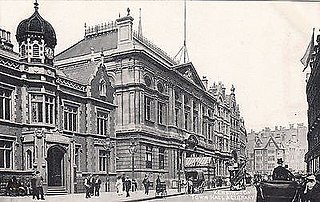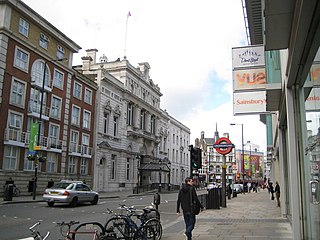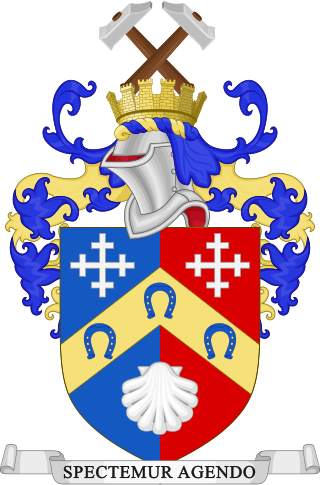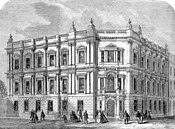
St Pancras was a civil parish and metropolitan borough in London, England. It was an ancient parish in the county of Middlesex, governed by an administrative vestry. The parish was included in the area of responsibility of the Metropolitan Board of Works in 1855 and became part of the County of London in 1889. The parish of St Pancras became a metropolitan borough in 1900, following the London Government Act 1899, with the parish vestry replaced by a borough council. In 1965 the borough was abolished and its former area became part of the London Borough of Camden in Greater London.

Islington was a civil parish and metropolitan borough in London, England. It was an ancient parish within the county of Middlesex, and formed part of The Metropolis from 1855. The parish was transferred to the County of London in 1889 and became a metropolitan borough in 1900. It was amalgamated with the Metropolitan Borough of Finsbury to form the London Borough of Islington in Greater London in 1965.

The Metropolitan Borough of Chelsea was a metropolitan borough of the County of London between 1900 and 1965. It was created by the London Government Act 1899 from most of the ancient parish of Chelsea. Following the London Government Act 1963, it was amalgamated with the Royal Borough of Kensington in 1965 to form the Royal Borough of Kensington and Chelsea.

The Metropolitan Borough of Kensington was a metropolitan borough in the County of London from 1900 to 1965, which since 1901 was known as the Royal Borough of Kensington, following the death of Queen Victoria, in accordance with her wishes.

The Metropolitan Borough of Fulham was a metropolitan borough in the County of London between 1900 and 1965, when it was merged with the Metropolitan Borough of Hammersmith to form the London Borough of Hammersmith and Fulham. It was a riverside borough, and comprised the many centuries-long definition of Fulham so included parts often considered of independent character today Walham Green, Parsons Green, Hurlingham, Sands End and that part of Chelsea Harbour west of Counter's Creek. The SW6 postal district approximately follows this as does the direct, though less empowered, predecessor Fulham civil parish.

The Metropolitan Borough of Hammersmith was a metropolitan borough in London, England from 1900 to 1965. It included Hammersmith, Wormwood Scrubs, Old Oak Common and Shepherd's Bush.

Battersea was a civil parish and metropolitan borough in the County of London, England. In 1965, the borough was abolished and its area combined with parts of the Metropolitan Borough of Wandsworth to form the London Borough of Wandsworth. The borough was administered from Battersea Town Hall on Lavender Hill. That building is now Battersea Arts Centre.

The London Government Act 1899 was an act of the Parliament of the United Kingdom that reformed the administration of the capital. The act divided the County of London into 28 metropolitan boroughs, replacing the 42 local authorities administering the area. The legislation also transferred a few powers from the London County Council to the boroughs, and removed a number of boundary anomalies. The first elections to the new boroughs were held on 1 November 1900.

The Metropolis Management Act 1855 was an act of the Parliament of the United Kingdom that created the Metropolitan Board of Works, a London-wide body to co-ordinate the construction of the city's infrastructure. The act also created a second tier of local government consisting of parish vestries and district boards of works. The Metropolitan Board of Works was the forerunner of the London County Council.
Bermondsey was a parish in the metropolitan area of London, England.

Strand was a local government district within the metropolitan area of London, England, from 1855 to 1900.

St Giles District was a local government district in the metropolitan area of London, England from 1855 to 1900. The district was created by the Metropolis Management Act 1855, and comprised the civil parish of St Giles in the Fields and St George Bloomsbury, Middlesex: the two parishes had been combined for civil purposes in 1774. The district was abolished in 1900 and its former area became part of the Metropolitan Borough of Holborn. The civil parish was abolished in 1930. It is now part of the London Borough of Camden.

Hammersmith was a civil parish in London, England, from 1834 to 1965. The hamlet of Hammersmith in the parish of Fulham had been governed by the Hammersmith Vestry following the construction of the chapel of St Paul's in 1629–1631. The Hammersmith Parish Act 1834 made formal the separation from Fulham. The parish was recombined with Fulham as the Fulham District for civil purposes from 1855 to 1886 and for the New Poor Law from 1845 to 1889. In 1900 the parish was superseded for local government by the Metropolitan Borough of Hammersmith. The parish continued to be used for election of boards of guardians until 1930 and was abolished in 1965. Its former area now forms the northern part of the London Borough of Hammersmith and Fulham.
Fulham was a local government district within the metropolitan area of London, England from 1855 to 1886. It was formed by the Metropolis Management Act 1855 and was governed by the Fulham District Board of Works, which consisted of elected vestrymen from the parishes of Fulham and Hammersmith.
The Fulham District Board of Works was a board of works for the parishes of Fulham and Hammersmith from 1855 to 1886.

The Hammersmith Metropolitan Borough Council, formally The Mayor, Aldermen and Councillors of the Metropolitan Borough of Hammersmith, was the local authority for the Metropolitan Borough of Hammersmith, which existed from 1900 to 1965.

The Metropolis Management Amendment Act 1885 was an act of the Parliament of the United Kingdom that amended the Metropolis Management Act 1855 and other Metropolis Management Acts.

The Clerkenwell Vestry was the vestry of Clerkenwell from c.16th century until 1900. The vestry had growing secular authority over the parish with the relief of the poor its main responsibility. It was incorporated in 1855 as an administrative vestry within the Metropolitan Board of Works area, with local government and sanitary rights and responsibilities added over time.
The St Luke's Vestry was the vestry of St Luke's, an urbanised parish north of the City of London, from 1733 until 1900. The vestry had growing secular authority over the parish with the relief of the poor its main responsibility. It was incorporated in 1855 as an administrative vestry within the Metropolitan Board of Works area, with local government and sanitary rights and responsibilities added over time.















